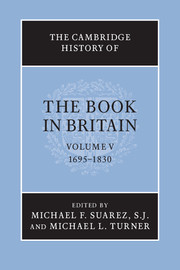Book contents
- Frontmatter
- Introduction
- PART I THE QUANTITY AND NATURE OF PRINTED MATTER
- PART II ECONOMIC, LEGAL AND CULTURAL CONTEXTS
- PART III THE TECHNOLOGIES AND AESTHETICS OF BOOK PRODUCTION
- PART IV THE BOOK TRADE AND ITS MARKETS
- I LONDON AND THE ‘COUNTRY’
- II TWO CASE STUDIES
- III SERIAL PUBLICATION AND THE TRADE
- IV THE INTERNATIONAL MARKET
- 26 Continental imports to Britain, 1695–1740
- 27 The English book on the Continent
- 28 The British book in North America
- 29 The British book in India
- V BOOKS AND THEIR READERS
- Abbreviations used in bibliography
- Bibliography
- Index
- Frontispiece
- Plate section
29 - The British book in India
from IV - THE INTERNATIONAL MARKET
Published online by Cambridge University Press: 28 September 2010
- Frontmatter
- Introduction
- PART I THE QUANTITY AND NATURE OF PRINTED MATTER
- PART II ECONOMIC, LEGAL AND CULTURAL CONTEXTS
- PART III THE TECHNOLOGIES AND AESTHETICS OF BOOK PRODUCTION
- PART IV THE BOOK TRADE AND ITS MARKETS
- I LONDON AND THE ‘COUNTRY’
- II TWO CASE STUDIES
- III SERIAL PUBLICATION AND THE TRADE
- IV THE INTERNATIONAL MARKET
- 26 Continental imports to Britain, 1695–1740
- 27 The English book on the Continent
- 28 The British book in North America
- 29 The British book in India
- V BOOKS AND THEIR READERS
- Abbreviations used in bibliography
- Bibliography
- Index
- Frontispiece
- Plate section
Summary
Three stages may be distinguished in the book-trade relationship between Britain and India during this period. Up to and including the third quarter of the eighteenth century, the British in India were entirely dependent for reading matter upon books published in Britain, only the few Christian works and almanacs printed by missionary presses such as Tranquebar and Vepery (Madras) being available locally. During the last quarter of the eighteenth century, commercial book and newspaper publishing sprang up in India on a limited scale, so that some information and recreational reading needs could be satisfied locally, but the overwhelming majority were still met through imports. Finally, during the early nineteenth century, a recognizably two-way traffic in books between Britain and India began to develop, as interest in Indian affairs increased in the former, driven by career opportunities as much as by intellectual curiosity.
This chapter describes the various purposes for which books were exported from Britain, the scale of that export trade, and the emergence of an embryonic infrastructure for book selling and distribution within India. Publication in India of English-language works remained in its infancy, however, and book imports from Britain still vastly outweighed exports from India to Britain at the end of our period. The attention of London booksellers was confined principally to contemporary works on Indian affairs and history, and pioneering investigations into the languages, literatures and culture of the subcontinent. By 1800 only thirty-six works of creative literature in English had been published in India. By 1830 that figure had increased, but not dramatically. India remained on the periphery of an English-language book culture centred on London, even if books were no longer imported only from Britain.
Keywords
- Type
- Chapter
- Information
- The Cambridge History of the Book in Britain , pp. 560 - 576Publisher: Cambridge University PressPrint publication year: 2009



